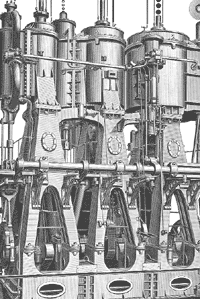 |
Introduction |
 |
 |
In this extract, written in the summer of 1894, Franklin describes being woken early one Sunday morning by two of his colleagues, who were very excited by their experiences of the previous evening.
The picture (right) shows detail of Hoovenaars's steam-powered drum machine. It is printed with the kind permission of the Estate of Aafke van Hoovernaars.
 |
 |
 |
 |
 |
 |
 |
*** Update, 23 May 2003 ***
Since Franklin's journal was published, the Museum has been alerted of an important find - a wax cylinder recording of van Hoovernaars introducing his steam-powered drum machine at a public gathering in the late 1800s.
Details... |
 |
 |
 |
 |
 |
 |
 |
|
 |
Sunday 11th August
Was awoken not after 6:00am from another fitful night's sleep by an unmerciful beating at my door. For a while sheer anger mastered me. I arose with the purpose in mind to fully remonstrate with whomever had launched so impetuous an interruption. On hearing manic laughter from the street, I readied myself for an altercation with some inebriated moon-calf but to my amazement, when I opened the door the faces that greeted me were those of my friends and colleagues Richkin and Quincey-Morris.
[NB- John Richkin Professor of Anthropology and one of the founders of University College, Liverpool; Dr. R. Quincey-Morris Dean of Edinburgh University 1882-1889].
I had half a mind to tell them there and then, that whatever their purpose for calling I would attend to their wishes at a more solicitous hour. However, the opportunity to do so was lost, as Quincey followed by Richkin bounded past with a wide-eyed enthusiasm. This new-found zeal was as much a surprise to me as the bombast of their entrée thêatricale.
[NB- Whilst on secondment to the Université de Paris 1881-1882, Franklin observed many different kinds of people's entrances]
When the maid entered with a pot of tea and my early morning laudanum, my cultured friends, in a suddenly nigh-incomprehensible heathen dialect, unleashed a lengthy and lurid diatribe of the previous evening's events. From what I could understand it appeared that they had left a meeting together at around 8.30 pm. Through an astonishing lapse, they had strolled into Seaforth & Litherland (a squalid working class area) and narrowly avoided being run down by a long line of speeding carriages, the passengers of which appeared to be in the highest of spirits. According to Richkin, soon after they left the street, the constabulary followed, but the procession had long gone.
Baffled by this event both Quincey and Richkin endeavored to investigate further and hailed a taxi. The taxi master revealed that on that night would take place an event described as "The Sunrise All-nighter", at a secret dockland location. Further interrogation revealed that a Professor Guus Van Hoovenaars of Utrecht was there expected to demonstrate an incredible new machine, capable of producing a rhythmical drumbeat "to quicken the blood" and "strike terror into the hearts of men".
Quincey's love of all things musical, as well as my colleagues' burning curiosity to experience the very latest innovations of our modern world, led them to track the procession of revellers through Liverpool's network of slums and warehouses.
Eventually the pair were led to a disused East India Company warehouse in the Southern docklands, a most unfavorable location under any other circumstances. However, Richkin maintains to this day that the assembled crowd included society names such as Mrs. Siddons, the wit and essayist Charles Lamb, and Lord and Lady Rimmer of Freshfield - all come to rub shoulders with the foundlings and workhouse rabble-rousers of the very lowest orders.
Richkin then proceeded to describe the interior workings of the warehouse. At this point he was literally foaming at the mouth with excitement. He likened the experience to being submerged in a child's kaleidoscope: Van Hoovenaars had erected a system of stained concave lenses and lime lights to project coloured images onto enormous canvas sheets, an effect Quincey described as "both disorientating and compelling".
Soon after the crowd had entered, the doors were locked tight so as to prevent intrusion from representatives of the Law. Van Hoovenaars then unveiled a huge and terrifying contraption. A multitude of brass pistons, steam cylinders and horns had been fashioned together, as like the internal frame of a fire-spewing Behemoth burst forth from teutonic myth. The professor addressed his audience, explaining that each piston reverberated on to a canvas of varying thickness to produce a series of rythmatic beats. He warned the gathering that once set in motion the machine "would produce such rhythms that man has never dared imagine - over an eleven hour period".
In mixed trepidation and awe, Richkin and Quincey looked on as the fierce contraption was set in motion. The machine let forth a tidal wave of bass terror louder yet than the mighty 'Long Tom' of Her Majesty's 7th battalion. Then there followed more beats of varying pitch and frequency. Richkin believed he could feel the vibrations of Van Hoovenaars monster shaking his organs of digestion.
[NB-'Long Tom' cannon employed by Baden Powell during the Boer War]
Soon after the machine had been set in motion, the crowd had begun to move their feet in time with the beats produced. It was, Quincey enthused, like watching blades of grass in the wind helplessly succumbing to a higher force of Nature. Driven by the thunderous rhythms of Hoovenaars tremendous "drum machine" the crowd - academics and dockers, architects and cobblers - were whipped into a frenzy, dancing and screaming like savages until sunrise, when the Machine finally ground to a halt with a suffering hiss.
The story, as unfathomable as it may be, fuelled the darker elements of my curiosity, and I have agreed to accompany my friends this following weekend on an overnight excursion to Blackburn to see Van Hoovernaars "drum machine" with my own eyes. |
|

